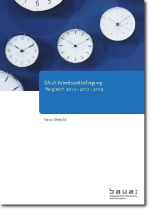BAuA Working Time Survey: Commuting, Telework, Business Trips, Changing and Mobile Work Places
(in German)
For many employees, mobility is a crucial part of their everyday working life. Mobility manifests itself in different ways. The report addresses some forms of work-related mobility: Commuting to and from work, working from home or teleworking, business trips and overnight stays away from home, mobile or changing places of work, and the combination of different forms of work-related mobility. Based on data from the BAuA-Working Time Survey 2017, the prevalence of different forms of work-related mobility is outlined. In addition, several working conditions associated with forms of work-related mobility are characterized, i. e. job stressors and job resources. Stressors are rather demanding working conditions, such as work intensity and temporal boundarylessness (e. g. overtime or availability outside working hours). Resources are beneficial or supportive working conditions, such as social support, decision latitude and working time autonomy. In addition, correlations between work-related mobility and aspects of work-life balance, recovery, and health are examined.
The results show that the different forms of mobility vary in prevalence: 7 percent of employees are long-distance commuters (120 minutes or more commuting time per day), 12 percent have a teleworking agreement, 36 percent of employees are business travellers, and 28 percent report overnight stays away from home. For 25 per cent, mobility is a crucial part of their workplace characteristics; they work mainly at changing or mobile workplaces, such as professional drivers or construction site workers. In addition, around 10 percent of employees have a combination of at least two extreme forms of work-related mobility (e.g. employees with changing or mobile work places who also frequently spend the night away from home due to work-related reasons).
The forms of work-related mobility are accompanied by different constellations of job stressors and job resources. Many forms of work-related mobility are related to a higher work intensity or temporal boundarylessness (e. g. working from home). Some of these forms are accompanied by a high degree of decision latitude and working time autonomy (e.g. business trips and overnight stays away from home). Along with the mobility-related absence from the workplace, the sense of community and social support at work are often less pronounced.
In many cases, occupations and the associated tasks are crucial for the impact of work-related mobility on work-life balance, recovery, and health. However, the resources and stressors addressed in this report appear to be suitable starting points for organizations to shape work-related mobility in order to promote occupational safety and health as well as the compatibility of work and private life.
Please download the complete report "BAuA Working Time Survey: Commuting, Telework, Business Trips, Changing and Mobile Work Places" (in German only).
Bibliographic information
Title: BAuA-Arbeitszeitbefragung: Pendeln, Telearbeit, Dienstreisen, wechselnde und mobile Arbeitsorte.
1. edition.
Dortmund:
Bundesanstalt für Arbeitsschutz und Arbeitsmedizin, 2020.
ISBN: 978-3-88261-292-9, pages: 233, Project number: F 2452, PDF file, DOI: 10.21934/baua:bericht20200713


